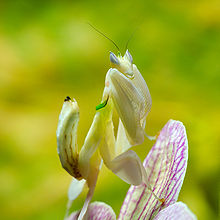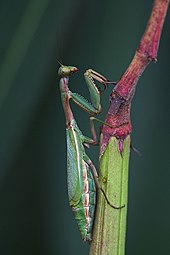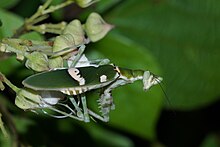Fishing horror
| Fishing horror | ||||||||||||
|---|---|---|---|---|---|---|---|---|---|---|---|---|

European praying mantis couple ( Mantis religiosa ) |
||||||||||||
| Systematics | ||||||||||||
|
||||||||||||
| Scientific name | ||||||||||||
| Mantodea | ||||||||||||
| Burmeister , 1838 |
The mantis or praying mantises (Mantodea) are a fine of insects and are among the winged insects (Pterygota). They are often referred to as mantids .
description
Praying mantises have - especially in connection with their often long-lasting immobility - very good camouflage. The body length of most species is between 40 and 80 mm. The smallest praying mantises are the original representatives of the genus Mantoida from South America, the smallest species Mantoida tenuis measures only about 12 mm. The largest species are found in the genera Toxodera and Ischnomantis with almost 160 mm.
In addition to the transformation of the first pair of legs into muzzle legs, the mantis owe their appearance, which is unusual for insects, to an extension of the first breast segment ( prothorax ), which greatly expands the range of action of the muzzle . The triangular head of the animals is connected to the prothorax via the neck (cervix). Unlike almost all other insects, the head of the praying mantis can be turned over a large angle. This transformation of the thorax with the rotation of the head is found otherwise only in the snakeflies and in the lacewings belonging catch sticking .

The fishing legs of the terrors are formed from the tibia (lower leg) and the femur (thigh). The tibia has many thorns and a large terminal claw. It can be folded against the thorn-reinforced femur like a pocket knife. The hip joints ( coxa ) are also elongated and freely movable. With these catch legs, the fishing rod can strike in 0.1 seconds to catch a victim. Many species can even catch flies from the air with this precise catching device. In a lurking position, the fangs are raised and held against the body, which is why the animals were also called praying mantises.
The large compound eyes of the animals are far apart and thus enable stereoscopic vision. Since they are used to locate and track the prey as well as to precisely locate the sexual partner, they represent the most important sense organ of the animals. Another sense organ is the unpaired hearing organ between the rear hips of some species. With this you can hear tones in the range from 25 to 130 kHz . It is probably used to hear the sounding sounds of approaching bats during the flight. The so-called auditory fissure lies between the 2nd and 3rd pair of legs and is only 0.2 mm wide. Females have less hearing than males. Some species also have two hearing organs, which are arranged one below the other and can perceive different frequencies. Other species have no hearing organ at all.
behavior

Most fishing horrors, such as B. the ghost mantis ( Phyllocrania paradoxa ) or the European praying mantis ( Mantis religiosa ) are diurnal ambulance hunters , that is, they remain immobile for hours until a victim approaches them, which they then grab with their fangs . Many species show adaptations to their surroundings, which make it difficult for their prey to recognize them in their lurking position. Not only in the colors, which can be very variable within the species, but also through the body shape and leaf-like broadened cuticle duplicates ( praise ), they imitate parts of plants in their outer shape ( mimetics ). The ghost mantis looks very similar to dried leaves, other species imitate pieces of wood and twigs. It is discussed whether fishing horrors such as the devil flower ( Idolomantis diabolicus ) and Pseudocreobotra wahlbergii or Creobroter pictipennis , which resemble flowers and blossoms, can attract insects through their shape and color. This would be a form of Peckham's mimicry .
Other types, e.g. B. the small Astmantis ( Popa spurca ) or species of the genera Eremiaphila and Heteronutarsus , which occur in the deserts and semi-deserts of northern Africa to India, run around very quickly and a lot to pursue their prey. Most species feed on insects and spiders . However, there are also some larger representatives that can also prey on scorpions and even small vertebrates such as young snakes , lizards , hummingbirds and small mammals . In July 2017 it was published that praying mantises in 13 countries on all continents also feed on smaller birds. The captured birds are 24 species from 14 bird families. These findings suggest that praying mantises can threaten certain bird species if they are increasingly used for pest control.
The catching horrors have an extensive courtship behavior , which mainly serves to ensure that the male can safely approach the mostly larger female. Nevertheless, it can happen that the male is partially or completely eaten by the female before or during mating ( cannibalism ), whereby this does not affect the copulation. The eggs are laid in large egg packets ( oothecae ). Some species reproduce through parthenogenesis .
Enemies and defense

Like many smaller and predatory animals, catching horrors are also involved in a diverse predator-prey relationship , which makes them both predators and the food spectrum of other animals. Vertebrates, including various reptiles , amphibians , birds and some mammals (especially bats ) play a major role as predators of the terrors . However, fishing horrors also belong to the range of prey for other predatory arthropods, such as larger carnivorous insects , arachnids or centipedes . Important enemies among the insects are some hymenoptera , especially ants and larger wasps such as the Asian giant hornet . Likewise, the hornet can fall prey to major fishing hornets. Smaller fishing horrors, including juveniles, can also be captured by larger fishing horrors (including those of the same species) due to their cannibalistic behavior. Fishing rods also serve as hosts to various parasites. A prominent example among them are the string worms , the young forms of which attack predatory arthropods, sometimes also fishing horrors, and induce them to seek out bodies of water and drown themselves in them by means of dehydration and control. The worms then leave the terrors and continue their way of life.

Terrors have developed various defense mechanisms in the course of evolution, including the adapted camouflage and threatening postures of many species. The larvae and nymphs of many species also imitate ants, as these are avoided by many animals. Most fishing horrors use their habitat-adapted appearance, in addition to their motionless behavior, not only to stay hidden from prey, but also to hide from predators. Various catchers also have false eye spots and / or warning colors on the inside of the tentacles and the underside of the second pair of wings. These are held up against a potential attacker should a fishing insect feel threatened by such a person. In dire straits, mantis flee or use their thorny tentacles and mandibles to defend themselves. As already mentioned, the males, which are often capable of flying, can also perceive the echo sounds of bats with their hearing organs and thus avoid them in good time. In doing so, the catching insect usually drops suddenly to the ground.
distribution

With the exception of the polar regions, fishing horrors can be found in all continents of the world. Although the different species inhabit different habitats, all are predominantly heat-loving. Many species live in rainforests , others come from savannahs , steppes , etc. in front. Some species, such as the European praying mantis ( Mantis religiosa ) or the great Chinese mantis ( Tenodera sinensis ) are quite adaptable and inhabit a variety of habitats, including human settlements. The two species mentioned and Tenodera angustipennis were also introduced in North America and were able to establish themselves there successfully.
Of the more than 2,400 known species, 36 species live in Europe, only one species lives in Central Europe, the European praying mantis, all the others are found in the tropics and subtropics. In addition to Mantis religiosa , Iris oratoria , Geomantis larvoides , Apteromantis aptera , Perlamantis alliberti , Bolivaria brachyptera , as well as several species of the genera Ameles (e.g. Ameles spallanzania ), Rivetina , Pseudoyersinia and Empusa (e.g. Empusa pennata ) can be found in the European Mediterranean area or Empusa fasciata ). Iris polystictica is also found in the southeastern part of Ukraine .
Fossil are representatives of the fishing horror in various amber deposits , especially in the Baltic amber ( Eocene ). The oldest amber inclusion with a fishing insect from the Chaeteessidae family comes from the so-called New Jersey amber (USA) (Upper Chalk , Turonium ).
Systematics







External system
Fishing horrors are very closely related to cockroaches (Blattodea) and termites (Isoptera) and, according to most current textbooks, together with these form the superordinate order Dictyoptera (now alternatively understood by some taxonomists as an order). Some systematists summarize catching horrors, cockroaches, termites and ground lice (Zoraptera) in the common taxon Oothecariformia (see also the systematics of gladiators ).
Internal system
The terrors are classified into different families. Subordinates are not used so far The following system, shown down to the level of the subfamilies, follows the taxonomic database of fishing horrors and has been supplemented by some more well-known species:
-
Acanthopidae
Burmeister , 1838
-
Acanthopinae Burmeister , 1838
- Leaf mantis ( Acanthops falcata Stål , 1877)
- Acontistinae Hebard , 1924
- Stenophyllinae Giglio-Tos , 1919
-
Acanthopinae Burmeister , 1838
-
Amorphoscelidae Stål , 1877
- Amorphoscelinae Stål , 1877
- Paraoxypilinae Giglio-Tos , 1913
- Perlamantinae Giglio-Tos , 1913
- † Baissomantidae Gratshev & Zherikhin , 1993
-
Chaeteessidae Handlirsch , 1926
- Chaeteessinae
- † Cretomantidae Gratshev & Zherikhin , 1993
-
Empusidae Burmeister , 1838
-
Blepharodinae Beier , 1964
- Little devil flower ( Blepharopsis mendica ( Fabricius , 1775))
- Devil Flower ( Idolomantis diabolica ( Saussure , 1869))
-
Empusinae Saussure , 1893
- Empusa pennata ( Thunberg , 1815)
- Empusa fasciata Brullé , 1832
- Walking violin ( Gongylus gongylodes ( Linnaeus , 1758))
-
Blepharodinae Beier , 1964
- Eremiaphilidae Wood-Mason , 1889
-
Hymenopodidae Chopard , 1949
- Acromantinae Giglio-Tos , 1919
-
Epaphroditinae Giglio-Tos , 1919
- Ghost mantis ( Phyllocrania paradoxa Burmeister , 1838)
-
Hymenopodinae Giglio-Tos , 1919
- Asian flower mantis ( Creobroter gemmatus )
- Yellow orchid mantis ( Helvia cardinalis Stål , 1877)
- Orchid mantis ( Hymenopus coronatus ( Olivier , 1792))
- West African mantis ( Pseudocreobotra ocellata ( Beauvois , 1805))
- African flower mantis ( Pseudocreobotra wahlbergii Stål , 1871)
- Small flower mantis ( Pseudoharpax virescens ( Serville , 1839))
- Oxypilinae Giglio-Tos , 1919
-
Iridopterygidae Giglio-Tos , 1919
- Hapalomantinae
- Iridopteryginae Giglio-Tos , 1919
- Nanomantinae
- Tropidomantinae
-
Liturgusidae Giglio-Tos , 1919
- Liturgusinae Giglio-Tos , 1919
-
Mantidae Burmeister , 1838
-
Amelinae Giglio-Tos , 1919
- Lesser fishing insect ( Ameles spallanziana ( Rossi , 1792))
- Gray fishing insect ( Ameles decolor ( Charpentier , 1825))
- Fuentes short-winged fishing insect ( Apteromantis aptera ( Fuente , 1894))
- Angelinae Beier , 1964
- Antemninae Terra , 1995
- Choeradodinae Kirby , 1904
- Chroicopterinae
- Compsothespinae Handlirsch , 1926
-
Deroplatyinae Giglio-Tos , 1919
- Dead leaf ( Deroplatys lobata ( Guérin-Méneville , 1838))
- Dystactinae
-
Mantinae Burmeister , 1838
- Australian giant mantis ( Hierodula majuscula ( Tindale , 1923))
- Indian great praying mantis ( Hierodula membranacea ( Burmeister , 1838))
- Hierodula patellifera ( Audinet-Serville , 1839)
- European praying mantis ( Mantis religiosa ( Linnaeus , 1758))
- Parasphendale agrionina ( Gerstaecker , 1869)
- Marbled Madagascar mantis (Polyspilota aeruginosa ( Goeze 1778))
- Green shield mantis ( Rhombodera basalis De Haan , 1842)
- Sphodromantis baccettii LaGreca & Lombardo , 1987
- African praying mantis ( Sphodromantis gastrica ( Stål , 1858))
- Ghana praying mantis ( Sphodromantis lineola ( Burmeister , 1838))
- African giant mantis ( Sphodromantis viridis ( Forsskål , 1775))
- Japanese giant mantis ( Tenodera aridifolia ( Stoll , 1813))
- Great Chinese mantis ( Tenodera sinensis Saussure , 1871)
- Mellierinae Giglio-Tos , 1919
-
Miomantinae
- Geomantis larvoides Pantel , 1896
- Miomantis binotata ( Giglio-Tos , 1911)
- Egyptian praying mantis ( Miomantis paykullii Stål , 1871)
- Orthoderinae Saussure , 1869
- Oxyothespinae Giglio-Tos , 1919
- Photinainae Giglio-Tos , 1919
- Phyllotheliinae
- Schizocephalinae Beier , 1964
- Stagmatopterinae Giglio-Tos , 1919
-
Stagmomantinae Giglio-Tos , 1919
- Stagmomantis carolina ( Johansson , 1763)
-
Vatinae Saussure , 1893
- Small Astmantis ( Popa spurca Stål , 1856)
-
Amelinae Giglio-Tos , 1919
-
Mantoididae Giglio-Tos , 1927
- Mantoidinae
-
Metallyticidae Chopard , 1949
- Metallyticinae
-
Sibyllidae Stål , 1872
- Sibyllinae Giglio-Tos , 1919
-
Tarachodidae Handlirsch , 1930
- Caliridinae Giglio-Tos , 1919
- Tarachodinae Handlirsch , 1930
-
Thespidae Giglio-Tos , 1919
- Haaniinae Beier , 1964
- Hoplocoryphinae Kaltenbach , 1996
- Miopteryginae Kirby , 1904
- Oligonicinae Giglio-Tos , 1919
- Pseudomiopteriginae Giglio-Tos , 1919
- Thespinae Giglio-Tos , 1919
-
Toxoderidae Giglio-Tos , 1919
- Toxoderinae Giglio-Tos , 1919
Cultural meaning
- The Praying Mantis Kung Fu or Tang Lang Chuan is one of the animal styles of Kung Fu . It is based on the movements of the praying mantis and, according to legend, was developed by the monk Wang Lang in the period between the Ming Dynasty (1368-1644) and the Qing Dynasty (1644-1911) in the Shaolin Monastery in China .
- There is a heavy metal band called Praying Mantis who also use terrors on their record covers.
Web links
- Website about the keeping of mantids and mantids in general
- Close-ups of praying mantises in the film
Individual evidence
- ^ A b Claudia Heßler, Ingrid & Rudolf Bischoff: Mantiden - Faszinierende Lauerjäger , Edition Chimaira, Frankfurt am Main 2008, ISBN 3-930612-45-3
- ↑ a b c K. Günther, H.-J. Hannemann, F. Hieke, E. Königsmann & H. Schuman: Urania animal kingdom - insects. Urania-Verlag, Leipzig, Jena, Berlin 1994, ISBN 3-332-00498-0
- ↑ 3sat.de "The Alien Insect - The Praying Mantis" ( Memento of the original from September 16, 2008 in the Internet Archive ) Info: The archive link was automatically inserted and not yet checked. Please check the original and archive link according to the instructions and then remove this notice. , Summary of a program contribution from December 21, 2006.
- ↑ Praying mantises hunt birds all over the world. July 4, 2017. Retrieved July 4, 2017 . University of Basel, based on: Martin Nyffeler, Michael R. Maxwell, JV Remsen, Jr .: Bird predation by praying mantises: a global perspective The Wilson Journal of Ornithology (2017) 129 (2): pp. 331-344. doi : 10.1676 / 16-100.1
- ↑ a b Report on fishing horrors on frontline.thehindu.com ( Link )
- ↑ a b Report on the ultrasound perception of male terrors on National Geographic ( Link )
- ↑ Description of the Great Chinese Mantis on BioOne COMPLETE ( Link )
- ↑ Report on the infestation of string worms in muzzle fright on the Parasite of the Day website ( Link )
- ↑ "Ethology of Defenses against Predators" by Edmunds, Malcolm; Brunner, Dani (1999) pp. 282-293. ISBN 978-0-8018-6174-1 .
- ^ A b Otte, Daniel, Lauren Spearman and Martin BD Stiewe: Mantodea Species File Online . Version 1.0 / 4.0 (accessed on May 3, 2011)
- ↑ Mantodea in Fauna Europaea , as of March 19, 2015.
- ↑ Reinhard Ehrmann: Praying Mantis in Kopal and Bernstein (Insecta: Mantodea) , ARTHROPODA 7 (3): 2-8, 2 Tab., Wernigerode 1999, ISSN 0943-7274


